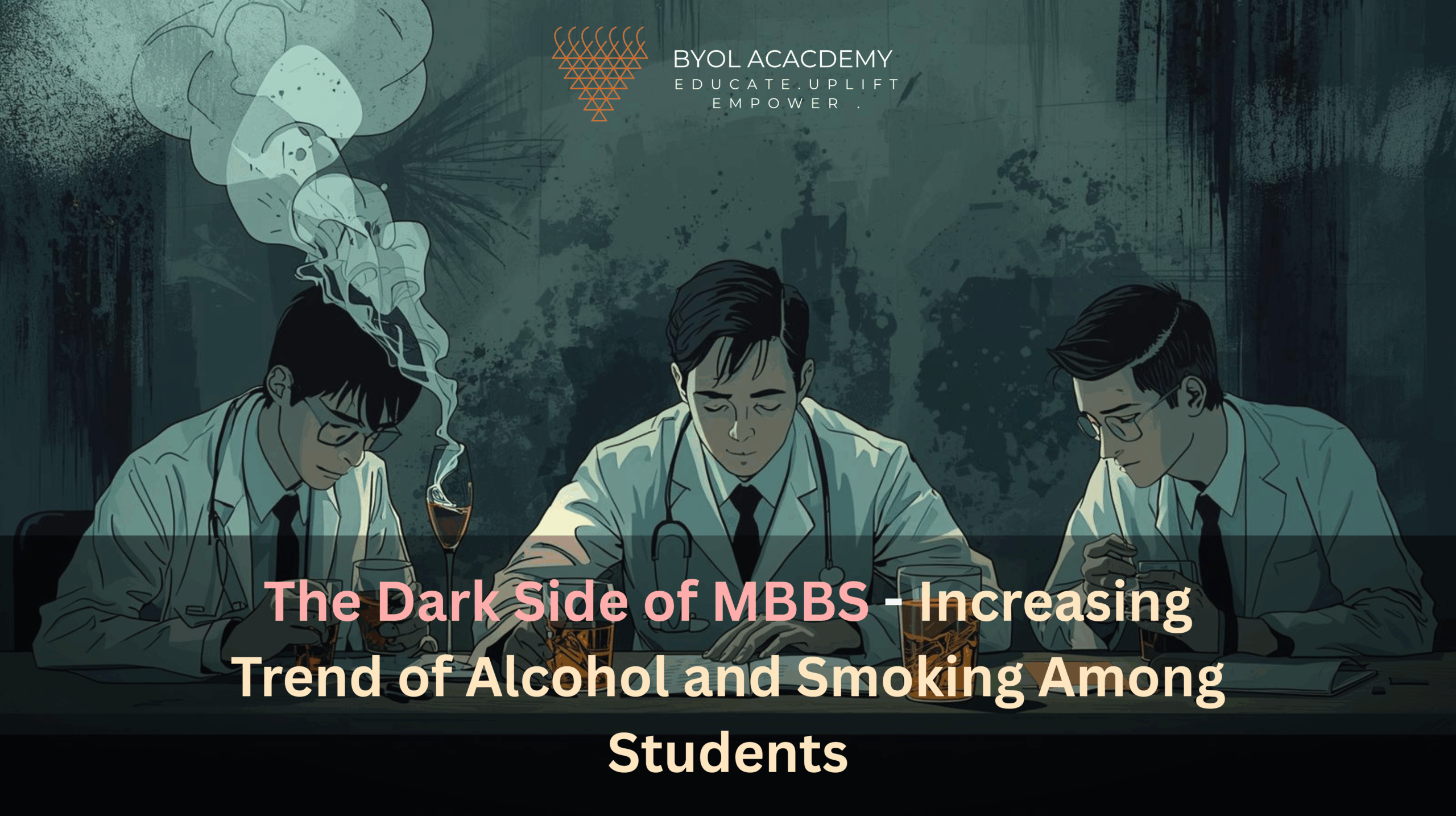A groundbreaking discovery reveals how glioblastoma erodes the skull itself – redefining what we know about brain cancer. It sounds […]
The Dark Side of MBBS – Increasing Trend of Alcohol and Smoking Among Students

Addiction to drugs like alcohol and cigarettes is becoming increasingly common among the young population. Many of these individuals leave their homes for the first time and are drawn towards smoking and drinking to look cool, especially under the influence of peer pressure and social media. Platforms like Instagram and Snapchat often showcase party culture where drinking and smoking are portrayed as symbols of confidence and popularity. This social media pressure to appear trendy
encourages many young people to try these substances just to post pictures or stories that make them seem socially active and accepted. The culture of songs and movies that glorify alcohol, smoking, and drugs further pushes them in the same direction. But these students don’ know about the long term side effects caused by such substance abuse. These incidents have been on the rise among students in engineering, medical, and other professional colleges.
Many young MBBS students are becoming increasingly addicted to such substances. One such cross-sectional study was conducted on MBBS students of PGIMS, Rohtak by the faculty of Pharmacology department of PGIMS Rohtak, Haryana, on 940 MBBS students between May to July 2023. The results were published in the Asian Journal of Medical Sciences on 1st January 2025
How was the Study Conducted?
Students who consented to participate in the study were assessed for their pattern and prevalence of substance abuse with the help of a structured self-administered questionnaire entitled “Pattern of Substance Abuse Among Medical Students” as a tool for data collection. The questionnaire had three main sections:
- Demographic characteristics of the participants such as age, gender, and year of study
- The Short Michigan Alcohol Screening Test (SMAST) related to the assessment of the severity of alcohol abuse among students
- The Fagerström Test for Nicotine Dependence (FTND) to measure the severity of nicotine dependence among students.
Apart from these three main sections, WHO-Alcohol, Smoking, and Substance Involvement Screening Test (ASSIST) – version 3 scale was also used to know the students’ experience of using these substances across their lifetime and in the past three months.
What is SMAST?
The Short Michigan Alcoholism Screening Test (SMAST) is a brief questionnaire designed to identify possible alcohol-use problems. It is derived from the longer Michigan Alcoholism Screening Test (MAST), which contains 25 questions, but is shorter and quicker to administer.
Being a screening test, it does not diagnose alcoholism by itself but indicates when a deeper evaluation is needed. The original SMAST contains 13 yes or no questions, each “yes” response being scored as 1 point.
A total score of 0 to 1 generally indicates no apparent alcohol problem, while a score of 2 to 3 suggests a possible alcohol issue and warrants further evaluation. Scores of 4 or higher stronglyindicate probable alcohol dependence, and the individual should undergo a more detailed clinical assessment.
What is FTND test?
The Fagerström Test for Nicotine Dependence (FTND) is a simple and widely used questionnaire designed to assess the level of physical dependence on nicotine among smokers. It consists of six questions that evaluate factors such as how soon a person smokes after waking, the number of cigarettes smoked per day, and the difficulty in refraining from smoking in restricted areas.
The total score helps classify dependence from very low to very high. A score of 1 to 2 shows low dependence, 3 to 4 indicates low to moderate dependence, 5 to 7 indicates moderate dependence, and a score of 8 or more indicates high nicotine dependence.
What is ASSIST version 3 scale?
The ASSIST (Alcohol, Smoking and Substance Involvement Screening Test) version 3, developed by the World Health Organisation, is a simple and reliable tool used to identify people who might be at risk of substance abuse. It includes 8 questions that cover substances such as tobacco, alcohol, cannabis, cocaine, sedatives, opioids, and others. The test looks at how often a person uses these substances, the problems caused by their use, and the risk of dependence. Based on the answers,
each substance receives a score that classifies the person’s risk as low, moderate, or high, helping healthcare professionals decide whether to offer brief advice, regular follow-up, or specialized treatment.
Results of the Study:
The study revealed that substance abuse was observed among nearly one-third of the students. Students who were residing in hostels were found to abuse a greater number of substances compared to day scholars. Alcohol and smoking emerged as the most commonly used substances among the students. Most of these students reported using only a single substance, while a smaller proportion indulged in both alcohol and smoking. The prevalence of substance use increased progressively with each academic year, showing the highest rates among final-year students.
A considerable number of students admitted that they began using substances due to mental stress during their studies, while peer pressure was identified as the major influencing factor for initiation. A positive family history of substance abuse was also noted as a contributing factor. Many final year students reported continuing substance use in an attempt to improve academic performance during examinations, whereas a large proportion of students across all years consumed substances mainly for enjoyment. Although several students made attempts to quit, most were unsuccessful due to lack of willpower, fear of withdrawal symptoms, and absence of motivation or support to
overcome addiction.
In terms of the SMAST (Short Michigan Alcohol Screening Test), the majority of students scored between 0 and 2, indicating little to no alcohol-related problems. However, a small group of students from the third and final years showed borderline scores, suggesting early signs of alcohol related issues that required further attention for their well-being and academic stability.
Regarding the Fagerström Test for Nicotine Dependence, most respondents demonstrated a low level of nicotine dependence, with only a few students showing moderate dependence levels. This suggests that while nicotine use exists among medical students, severe addiction remains relatively limited to a smaller subset of users.
Limitations of the Study:
As this was a descriptive cross-sectional study, a cause-and-effect relationship could not be established. The data were collected based on the self-reports of the participants, which may have been influenced by recall bias and underreporting of substance use due to social desirability and fear of consequences. Since the study was conducted by the faculty members of the same institution, some students might have hesitated to report their actual substance use habits honestly, fearing disciplinary action or negative judgment. This could have led to an underestimation of the true extent of substance abuse among the participants.
The study also did not include newer or less commonly discussed substances such as designer drugs, ephedrine, cannabis, cough syrups, prescription medications like alprazolam, and other hard core drugs that are increasingly being misused by young people. Their exclusion limits the understanding of the evolving pattern of substance use among students.
Another limitation was the absence of gender-based comparison. The study did not present findings that show differences in the incidence or severity of substance abuse between male and female students, which could have offered a clearer view of gender-specific patterns and risk factors. As the study was limited to a single institution, the findings may not be fully applicable to medical students in other colleges or regions where social, cultural, or academic pressures may differ.
Recommendations to NMC and Medical College Administrations across India:
Considering the alarming rise in substance use among medical students, there is a strong need for nationwide preventive and supportive measures. The National Medical Commission (NMC) should take a proactive role in addressing this growing concern by introducing structured programs across all medical colleges. Mandatory awareness sessions on substance abuse, mental health, and stress management should be conducted for every batch of students from their first year onward. The NMC could also recommend incorporating topics related to addiction, coping mechanisms, and peer influence into the medical curriculum under AETCOM modules, helping students understand both the health and social consequences of such behaviour.
Medical college authorities should establish confidential student wellness and counselling centres to provide psychological support and early intervention for those struggling with stress, anxiety, or substance use. Regular screening using validated tools like ASSIST, SMAST, and FTND can help identify at-risk students early, followed by counselling rather than punishment to encourage openness. Colleges should also organise mandatory interactive workshops and peer-support initiatives led by senior students and mental health professionals to promote a healthy, substance free campus culture.
Strict monitoring and random checking of hostel campuses and rooms should be carried out routinely to prevent the storage or use of alcohol, cigarettes, or any illegal substances within the premises. The concerned authorities and local administrations should ensure that cigarette stalls,
alcohol outlets, and wine shops are not located near or within medical college areas. Such preventive environmental measures can significantly reduce easy access and temptation among young students.
At a broader level, multi-centric studies under NMC guidance should be encouraged to monitor the prevalence and patterns of substance use among medical students nationwide. This would help in forming evidence-based policies and tailor interventions according to regional and institutional needs. With collective efforts from NMC, medical college administrations, faculty, and students, the medical community can take a decisive step towards curbing substance abuse and fostering a healthier learning environment for future doctors.




